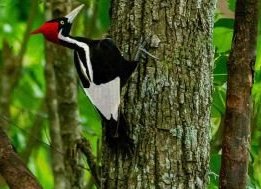------------------------------------------------------------
Was planning to post at very end of month, but since there's a new Washington Post article out today (mostly on the Latta/Michaels search and re-iteration of their confidence) I'll just dump all this now (hope you can open the link):
https://www.washingtonpost.com/climate-environment/2022/12/19/ivory-billed-woodpecker-extinct/
Feel like I end each year in recent times thinking that surely there MUST be definitive evidence of IBWOs next year or it's time to pack up this tent and go home (at least for the time being). Brits sometimes call those of us keeping stories like this alive, "stringers," for tossing out just enough crumbs to keep dragging the public along. Many interested parties have left the IBWO arena by now at the very same time that many newbies have entered it... with the enticing 'crumbs' still being regularly tossed about. My guess (once again) is that next year may well be crucial to any resolution (...or, NOT, haha). Would also guess that early in the year USFWS will choose to de-list, but that was my guess last go-around, so what do I know! (they will be roundly booed, no matter which decision they make!)...
The sorts of evidence and arguments that are regularly put forth now could fairly easily continue for a couple more decades... except that nobody wants that. And given the relatively small-scale and sporadic nature of current searches I'm not confident of the likelihood of success, but luck or lightning only need strike once; one really fine video, one active nesthole located, one recently-deceased carcass discovered, to change the narrative... So onward to 2023....
As far as some folks writing me to ask about South Carolina, I won’t go into muddy details or back-and-forth arguments other than to re-voice my personal view (unless/until significant evidence persuades otherwise), that IBWOs are most likely extirpated from S.C. (and Texas also, with 7 other states though remaining more likely).
But otherwise maybe just sign off to 2022 with this: ;)
------------------------------------------------------------
ADDENDA 12/22:
Will toss out just a couple more items/videos for perusal:
Matt Courtman got some further publicity on a local TV station for his efforts:
https://www.youtube.com/watch?v=vU6sed1P7rM
Searcher Mike Collins takes issue with the Latta/Michaels interpretation of the drone video they released earlier (Mike thinks it’s a definite, normal Pileated vs. possibility of IBWO):
https://www.youtube.com/watch?v=X8x_oY2F2nU
I don’t agree fully with Mike’s analysis here, but present this for the sake of pointing out that, unlike the unanimity some presume on the part of so-called “IBWO Truthers” there are actually a number of disagreements.
I tentatively lean toward the bird being either an IBWO or a leucistic PIWO (...and there are those who still think it a Red-headed Woodpecker). I would urge folks who wish to analyze it further to try and find one of the enlarged/enhanced copies of the video to view. But no desire here to debate back-and-forth what the bird is; simply waiting instead for a video that requires no debate or analysis.
-----------------------------------
ADDENDA2 12/24:
since I've started Addenda, may as well ramble on with a couple more:
1) a reader sends me this li'l history of the Singer Tract I don't recall seeing before:
https://sites.rootsweb.com/~lamadiso/articles/singer.htm
2) Some discussion of acoustic data over on FB lately, but a lingering problem is simply the lack of any "control" data-set; i.e. ideally we need to have ARUs (sound-recording devices) set up for an extended period in the deep woods of places like New Hampshire or Washington state or Montreal etc. (where there are no IBWOs) and then analyzed to see how many kent and DK-like sounds appear on those tapes, and whether they can be spectrographically (and diagnostically) distinguished from the relatively small (barely significant) sample of known IBWO sounds we have on record. Putative sounds can be interesting, but primarily only when they end up coming in conjunction with sightings, and less-so as stand-alone data.
As I noted elsewhere recently, by now IF the IBWO is ever fully documented what will be most significant of all is not the re-discovery, but rather what it exposes about the lack of rigor and science in ornithology that permitted the species to go missing over decades in the first place.
---------------------------------
ADDENDA3 12/29:
---------------------------------





